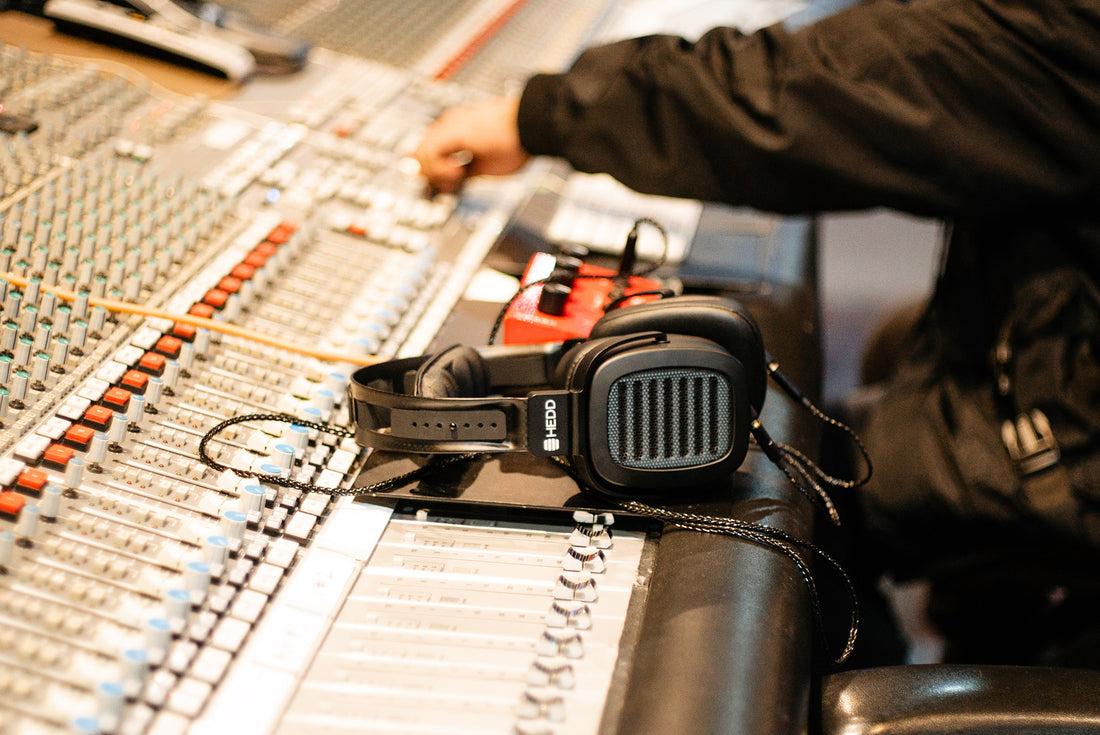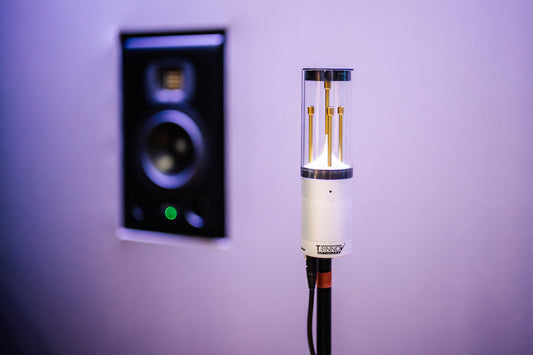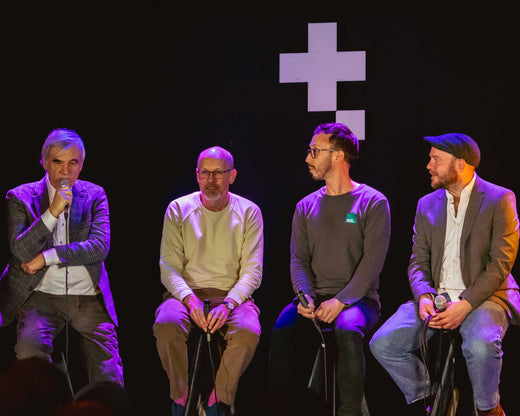
Working on Headphones: Five Engineers Share Their Perspective
Are headphones just for recording or listening back? Can you really finish a record without monitors? How can you trust headphones for mastering?! The truth is that music production and the technology behind it has evolved so much in the past two decades that most of the old rules and concerns don’t apply anymore.
There was a time when working solely on headphones could be considered a professional faux-pas, but you’d be surprised to hear how many mixes and masters have been finished on headphones in the back of a car! After all, people today listen to music in vastly different ways than they did just ten years ago and so professionals have also changed the way they work to bring that music to listeners' ears.
To try and untangle fact from fiction and get a sense of how headphones fit in a professional's workflow, we spoke to five leading mixing and mastering engineers about the role headphones play in their daily work and how that’s evolved over the years.
We've grouped their answers under the most common themes discussed, so read on to find out how and why professional mixing and mastering engineers use headphones in their work.
Headphones offer a freedom monitors can't
The most common thread in the answers we got was that headphones allow you to work in a more flexible way than speakers without sacrificing the quality of a mix or master.
Elaine Rasnake, Mastering Engineer - Philadelphia, USA (Boyscott, Chase Petra, Shallow Alcove): "Headphones allow me a great deal of freedom. They provide the freedom of mobility, I can pack up my studio and work almost anywhere in the world at the drop of a hat. They also give me the freedom to work at any time of day. I have a 1 year old child whom I take care of during the day, and I can work at night on my headphones without having to worry about waking her up."
TIEKS, Mix Engineer - London, UK (IAMDDB, Jax Jones, Florence & The Machine): "There was a point where I was mixing exclusively on SSL’s but then I had to mix the main single for a record by IAMDDB featuring Masego. He (Masego) is an amazing artist, but what you find with a lot of the big American artists is they have time constraints: they don't have time for you to do the things that you do as an analogue mixer, such as setting up stems or aligning tape machine, all this stuff. This record needed to be mixed in an analog way, but they didn't have the time for that, so I decided not to do it on the SSL and in fact I decided not to do it in a studio. I had some time at home and it was essentially done on my laptop and my HEDDphone®. That was it! And the record, as far as I'm concerned, sounds amazing."

“All the equipment I’ve traveled with for the last few years fits in one little Pelican case. It’s a laptop, a D-A, a UAD satellite, and the HEDDphone. That's it.” - Blue May
Blue May, Mix Engineer - Los Angeles, USA (Joy Crookes, Kano, Suki Waterhouse): "Headphones give me complete liberation - I can mix anywhere in the world, I can be in a hotel room, I can be in my room, I don't have to have a treated room. Joy Crooks’ first record (Skin, released in 2021), all of it was mixed on headphones in the living room of a house. I do also use them for tracking in the studio a little bit but it's just a quick check to make sure I'm in the right ballpark with what I’m hearing out the monitors, especially when I don't know the room fully, it just gives me a kind of constant that I can trust."
Headphones are all about the details
Sometimes you just need to focus and dial into the tiny changes that may be missed by the general public but which make artists happy, especially when they’re often checking mixes on headphones too.
Michalis "MsM" Michael, Mix Engineer - London, UK (Skepta, James Blake, A$AP Rocky): "Originally I tended to use headphones for the end of mix check, however my main use now is revisions and notes. That’s 50/50 with speakers. I noticed more and more artists would check the mix on headphones so it just felt logical. Then once I started doing it, notes from artists that used to bother me, maybe because I didn’t agree with them, started making sense. I understood the notes better."

Headphones allow me a fresh perspective. With them, I’m listening for tiny details that I may have missed on my monitors.” - Katie Tavini
TIEKS: "The headphones become important when I have to really zoom into a mix and get to the minutiae, finding all those finer details that need to be tied up like the clicks and the pops that you might miss when you're on monitors. On headphones you can take care of those fine details, things that can turn a good record into a finished, radio-ready record.
99% of people who listen to our records nowadays are listening on headphones, so I feel like when you're mixing on headphones you're putting yourself at an advantage because you're hearing it how the listening public are generally going to hear it. It's funny because I was mixing a record recently for a young R&B artist, she came to my studio and I had these big, expensive, £30,000, soffit-mounted monitors and everything sounded great and, you know she's in her 20s, she's part of the generation that only listen to things on their phones and she was like, "You know we don't all have these monitors to reference with." The negatives that people had of headphones in the past don't necessarily apply anymore because people are not sitting in their living rooms playing records on speakers like they were in previous decades. They are now listening on their phones via Spotify or Apple Music and it's probably going through a pair of AirPods.”
Details are also part of what the engineers we spoke with are looking for when listening to new headphone models. They shared with us the main characteristics they look for in a pair of headphones they will work with regularly.
Elaine Rasnake: "I look for transparency and the full range of sound. I don't really like headphones that have a specific sound or frequency bump to make things sound more "exciting." I want to be able to hear 20Hz through 20kHz as clearly as possible."

“99% of people who listen to our records nowadays are on headphones, so when you're mixing on headphones you're putting yourself at an advantage.” - TIEKS
MsM: "If the song is super bass-heavy or sibilant to the point of being problematic, I want the headphones to show me this, not present it beautifully. I want to hear the distortion, be it in the file itself, the compressor, or even the driver saying it’s had enough."
Blue May: "Since using the HEDDphone®, I'm not checking for new headphone models."
Working with both headphones and monitors
Increasingly, engineers and producers are using headphones in combination with speakers on a daily basis, so at some point you have to ask yourself: do I want them to be sonically integrated? Or, do I want headphones to give me something different?
Katie Tavini, Mastering Engineer - Liverpool, UK (Arlo Parks, Nadine Shah, John Glacier): "I picked the HEDDphone® because they sound nothing like my monitors, but they still give me the same "I can hear into the music" feeling as my monitors do. I wouldn’t want headphones that were too similar because what’s the point then?"
TIEKS: "I'm definitely somebody who wants my headphones and monitors to blend together. The thing that attracted me to the first HEDDphone® model was that they sounded so similar to my main monitors, which I'd been using for the last 10 years. I know these monitors inside out, I know how to get a good sounding record out of them. As soon as I heard the HEDDphone® I said, “Well I don't need these £7,000 monitors anymore!” But then also I knew I could trust them to finish a mix. I'm very demanding of all my gear - I like to think I've got really good ears and I can hear bad gear pretty quickly. There's a lot of expensive stuff that friends have bought and I've listened to and told them they’re wasting their time, but the HEDDphone®, they blew me away immediately and have been a brilliant investment."

“I tend to want headphones that feel like my speakers are on my head, but closer and with less room interaction.” - MsM
Blue May: “The reason why I chose and love the HEDDphone® is because they're the first and only pair of headphones that actually feel like listening to monitors to me. With every pair of headphones I've had, I always had to make adjustments afterwards - especially in the low end and the top end - but it was always quite shocking to see the kind of EQ moves I would have to do on those. Whereas the HEDDphone® are the first pair that feel like I'm sitting in a really balanced, treated room. It doesn't feel like a headphone sound stage, it just feels like music, with no added hype."
How relevant are monitors to mixing and mastering?
Some of the engineers we spoke to have decided to do away with speakers altogether, at least for the mixing and mastering stages. This remains a personal choice however, and it's about striking a balance that fits them and which can evolve based on working requirements.
Elaine Rasnake: “I got my first, and only, pair of monitors right out of college and I used them for audio work up until 2020, when I really got serious about mastering. When the COVID lockdown happened I was situated in a one bedroom apartment with my wife who needed to be on Zoom every day for work. So, I needed to find a way to do my audio work without distracting her or annoying our surrounding neighbors. I had done some research and learned about Glenn Schick who has worked with some big names in music (Playboi Carti, Future, J. Cole, T.I.) and also works in headphones. This was when I knew this route was professionally possible.
Do I miss having monitors? Honestly, no. I know a lot of folks talk about loving their monitors because of the feeling of the sound literally moving air, and the feeling of the kick drum pounding on their chest, but I never had this from the get-go and I suppose I get this feeling enough when I go to live shows."

“I don't really like headphones that have a specific sound or frequency bump to make things sound more exciting.” - Elaine Rasnake
Blue May: "At this point all of my work is pretty much 90% to 100% mixed on headphones, so eight, nine, ten hours a day sometimes. I couldn't go back, it's my absolute number one reference point."
Katie Tavini: "I tend to use headphones as a backup - I really love working on monitors but I love having headphones that sound as good as my monitors (but very different) for checks on little sections, if I need a change of scenery or if I need to double check whether there’s any distortion or clicks."
Tieks: "I was on my monitors probably for 70% of the time, moving to the headphones for the last 30% of the mix, getting all the details right. That's changed in the last seven or so months, where I am now pretty much wearing the headphones for 90%, if not 100% of a mix and a master. They have pretty much become my go-to monitor, I don't know when was the last time I plugged my main monitors in - probably about seven months ago! Any mix anyone would have heard of mine in the last six or seven months have all been done on the HEDDphone®."
In conclusion, it's not the tool...
Ultimately headphones and monitors are just tools, and it's how they are used that matters. As the engineers we've spoken to have made clear, you can be all in on headphones for mixing and mastering or you can use them as an additional way of checking your work alongside speakers and still achieve great quality that translates and pleases both artists and listeners.
With all the technological, and social, changes of the past decades there are now many different, and valid, ways to work as a mixing or mastering engineer. The key is to find the way that works for you.
Photo credits: Blue May by Felix Zimmermann; MsM by Marwan Elgamal.

